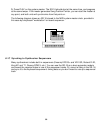
64
9.2B Mode Messages
There are two messages that determine the MIDI mode (i.e., how devices will receive MIDI
data). The "omni" message determines how many channels will be recognized. Omni on
means that data from all channels will be received; Omni off limits the number of channels,
usually to one.
The "mono/poly" message deals with voice assignment within the synthesizer. In Mono mode,
only one note at a time plays in response to voice messages; in Poly mode, as many voices
can play notes as are available to play notes.
The SR-16 offers the following:
Omni On/Poly (Mode 1) The SR-16 responds to MIDI data occuring on any channel.
Omni Off/Poly (Mode 3) The SR-16 is tuned to one channel and ignores other channels.
9.3 SYSTEM COMMON MESSAGES
Intended for all units in a system, some of these messages are:
Song Position Pointer This indicates how many "MIDI beats" (normally a 16th note) have
elapsed since a piece started (up to16,384 total beats). It is primarily used to allow different
sequencers and drum machines to auto-locate to each other so that if you start one
sequencer, the other device will automatically jump to the same place in the song,
whereupon both continue on together.
System Exclusive This message (called sys ex for short) is considered "exclusive"
because different manufacturers send and receive data over MIDI which is intended only for
that manufacturer's equipment. Example: sending an Alesis SR-16 message to an Ensoniq
VFX-SD or Roland MT-32 won't do anything but will be understood by other SR-16s. This
data often contains information about individual instrument patches (such as the SR-16
Pattern/Song/Drum Set information).
Timing Clock The SR-16 emits 24 timing messages per quarter note. Each device
synchronized to the SR-16 advances by 1/24th of a quarter note when it receives the clock
message, thus keeping units in sync after they've both started at the same time. However,
note that to provide an internal resolution of 96 timing messages per quarter note, the SR-16
internally subdivides the MIDI clock by a factor of four.
Start Signals all rhythmically-based units when to start playing.
Stop Signals all rhythmically-based units when to stop playing.
9.4 BOOKS ON MIDI
There have been many books written on MIDI; the following are just a few examples of what's
available.


















